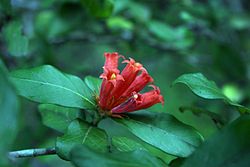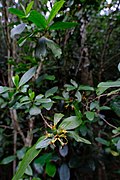| Burchellia bubalina | |
|---|---|
 | |
| Scientific classification | |
| Kingdom: | Plantae |
| Clade: | Tracheophytes |
| Clade: | Angiosperms |
| Clade: | Eudicots |
| Clade: | Asterids |
| Order: | Gentianales |
| Family: | Rubiaceae |
| Genus: | Burchellia R.Br. |
| Species: | B. bubalina |
| Binomial name | |
| Burchellia bubalina | |
| Synonyms | |
Genus
Species
| |
Burchellia is a monotypic genus of flowering plants in the family Rubiaceae. The genus contains only one species, viz. Burchellia bubalina, which is endemic to southern Africa: the Cape Provinces, KwaZulu-Natal and the Northern Provinces in South Africa, and Eswatini. [2] It is commonly known as wild pomegranate (English) or wildegranaat (Afrikaans). [3]



